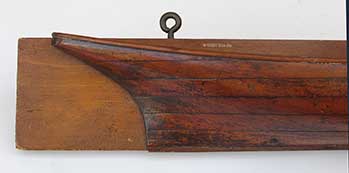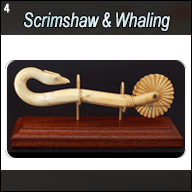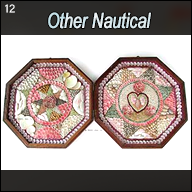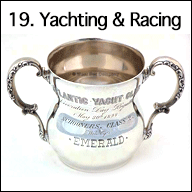2. Models & Half Hulls
Prices in U.S. Dollars are in GREEN
 |
2.96 SILVER MODEL. Delightful, cased model of a gaff-rigged sloop under full sail plying a wavy sea. The model has all 5 sails set and is flying a pennant from the mast. The mains’l shows mast hoops properly rigged. The solid silver hull shows simulated planking surrounding the cabin and cockpit. The helm is realistically portrayed with a classic ship’s wheel. The hull is marked “STERLING 960.” The entire presentation is housed under 5 panels of clear glass within its handsome original rich hardwood frame of pinned construction, The case measures 9 1/8 inches high by 5 inches wide and 8 inches long.. Superb original condition. An ideal gift for that significant yachtsman! WAS $895 NOW only 395 |
 |
 |
| model | yacht |
 |
| sterling |
 |
2.97 MINIATURE CLIPPER SHIP. Exceptional 19th century folk are model of an American clipper ship under full sail. This charming depiction features a 3-masted solid wooden hull square rigger plying a realist green putty sea with all sails set. The raised foc`sle and poop decks are realistically portrayed. The main deck has a large deck house and 2 hatches. The American ensign flies from the spanker and a long flowing pennant flies from the main. The model is mounted on its carved wooden stand with ball feet. Telling of its age, the model case in comprised of 5 panels of old wavy glass. The overall presentation is 8 ½ inches long, by 2 ¾ inches wide and 5 ¾ inches high. Outstanding original condition throughout. A very detailed, realistic model for such a diminutive size. SOLD From a noted world-class collection of maritime antiques and scrimshaw in Monterey, California. Provenance will be provided to the buyer. |
 |
 |
| perspective | reverse |
 |
 |
| ship | ship reverse |
 |
2.95 HALF HULL. Very nice 19th century builder’s half hull model of a coastal sailing craft. This especially handsome model is constructed in the traditional way with 6 sculpted pine lifts and a decoratively-applied cap rail. The keel continues to form a decorative stem. The graceful lines of this craft indicate it was a sailing vessel of one or two masts with a plumb bow and a distinctive camber. The shaped hull is mounted onto itsoriginal solid pine backboard measuring 22 ½ inches long by 3 ¼ inches high. All old original surfaces have acquired a rich, extremely desirable antique surface. Totally untouched. Pristine. The two original old eyelets are still present for hanging. Ready to display! Priced to sell. 595 Such an authentic, very attractive ship builders’ model over 150 years old, in this displayable size is rarely found in today’s market. Please google equivalents. |
 |
 |
| perspective | back |
 |
 |
| bow | stern |
 |
2.94 AMERICAN CLIPPERSHIP HULL. Very rare, genuine builder’s half hull model depicting the sleek early clippership RIALTO as identified on the back. The inscription reads “RIALTO 500 tons Built by Lyman Walker & His Son Lyman F. In the Walker Yard, Yarmouth, Maine 1851.” This handsome rendering of the ship shows the bulwark with a raised golden line above the waterline. The bulwark of the vessel is in black and the hull below the waterline is in dark red. It is complete with its attached rudder. The variegated surfaces of the entire presentation reveal its great age. Remarkably, there is no damage or modifications. Of particular note are the unusual mounts which consist of ropes fastened into the deck. 22 1/4 inches long by 4 ¼ inches thick. Simply outstanding original condition showing great age but absolutely no abuse, indicative of a shipbuilding family’s prized possession. Direct from a private estate in Maine. 995 |
 |
 |
| perspective | stern detail |
 |
 |
| surface | back |
 |
| identification |
 |
 |
 |
| reverse | bow |
 |
 |
| focsle | deck |
 |
 |
| stern | stern perspective |
 |
 |
| focsle detail | focsle perspective |
 |
| plate |
 |
2.89/12.16 RARE P.O.W. MODEL Exquisite Prisoner of War boxwood ship model made by French Prisoners of War in British prisons from 1775 until Napoleon’s defeat at the Battle of Waterloo in 1815. This incredible survivor from that splendid era is of a full-rigged, 3-masted 90 gun British ship of the line with the delicately-carved ivory figurehead of Neptune holding a spear. It flies the British ensign from the foremast, the long commissioning pennant streaming from the main and the squadron flag from the missen. The large British man-o-war flag flies from the spanker. This model is depicted on its waterline in a placid carved wooden sea with blue waves. Although appearing as a waterline model, it is actually a full hull model set into a slot in the sea! The hull is complete with keel, rudder and stem. What is remarkable is the originality of this model. It is totally untouched and complete with all lines and rigging in tact and in excellent condition. Deck detail is absolutely exquisite and near scale. Of note are the swivel guns and their mounts on the poop deck with its incredibly fine railing. The hatches are open revealing the interior of the ship into multiple decks below. The ship’s transom and galleries are wondrous in their minute detail. The model is mounted in its original wooden stand lined with bone panels adorned with typically iconic painted P.O.W. bone sashes. It is beautifully-displayed on a highest quality sculpted hardwood pedestal with felt base measuring 13 ½ inches long by 9 inches wide. This diminutive, exquisite miniature model measures a mere 8 ¾ inches long from bowsprit to spanker and 7 ¼ inches tall from the waterline to the main mast truck! Yet its detail is incomprehensible. It is complete within its custom-made rectangular glass dome. Inclusive of the glass dome the entire presentation measures 13 inches tall. Without a doubt this is a museum piece of the first order, circa 1800. SOLD Prisoner of War Ship Model authoritarian and author Ewart Freston writes in chapter 10, “The wood ships are superior to the bone and ivory models by reason of the fact that, not only are they more realist as regards appearance, but also because of their being of better proportions, and closer to the original in accuracy of detail. In the matter of the appearance, the fact of their being made of similar material to the original ships gives them as distinct advance over the bone models.” (Ewart C. Freeston. “Prisoner of War Whip Models 1775-1825.” 1973, Nautical Publishing Company Ltd. Limington, England, Camelot Press, Ltd. London and Southampton.) |
 |
 |
| ship | aft |
 |
 |
| figurehead | rigging |
 |
 |
| stern | waterline |
 |
 |
| hatch | comparison |
 |
2.86 RECOGNITION MODEL. Authentic World War II U.S. Navy recognition model of the North Hampton class cruiser USS LOUISVILLE (CA-28). Early in the War such models were commissioned by the U.S. Navy to train gunners, spotters and pilots in the all important task of recognizing ships as friend or foe. To those ends the scale and detail of this model are truly incredible, down to individual gun barrels and midship cranes. Realistically, even the large gun turrets rotate! 6 inches long with a beam of 1/8 inch and 1 ¼ inches high. This all cast metal model is in excellent original condition with no damage or missing parts. Made by “A. PRAM & CO. Chicago 12-44” as embossed on the bottom. 95 LOUISVILLE was commissioned on January 15, 1931 and saw service in the Pacific and Caribbean up until the day of infamy on December 7, 1941 she was dispatched for the Pacific theatre where she actively participated until war’s end. On June 5, 1945 LOUISVILLE was attacked by a Japanese kamikaze killing 8 crewmen and wounding 45 others. For her dedicated service in World War II LOUISVILLE was awarded 13 battle stars. |
 |
 |
| above | reverse |
 |
 |
| name | kamikaze |
 |
| ship |
 |
2.83 RECOGNITION MODEL. Genuine WWII miniature model of the famous World War II battlewagon the USS MASSACHUSETTS (BB-59). Early in the War such models were commissioned by the U.S. Navy to train gunners, spotters and pilots in the all important task of recognizing ships as friend or foe. To those ends the scale and detail of this model are truly incredible, down to individual gun barrels and even the spotter plane on the catapult of the fantail. 6 ¾ inches long with a beam of 1 ½ inches and 1 3/16 inches high. This all cast metal model is in excellent original condition with no damage or missing parts. 95 The USS MASSACHUSETTS (BB-59) was commissioned on May 9, 1942 and was dispatched to eastern front of the Atlantic where she participated in the Battle of Casablanca. In November she was assigned to the Pacific Fleet where she fought the Japanese in several famous engagements through War’s end. For her service she was awarded 11 battle stars. In January 1986 she was designated as a National Historic Place. She currently resides in Battleship Cove, Fall River, Massachusetts as a museum ship. |
 |
 |
| detail | bottom |
 |
| shiP |
 |
| IMAGES COMING SOON |
 |
 |
 |
| comparison | left |
 |
 |
| right | ship 1 |
 |
 |
| ship 2 | ship 3 |
 |
 |
| ship 4 | ship 5 |
 |
2.73 FIRST U.S. NAVY REPAIR SHIP. Here is a true-to-life miniature model of the first American repair ship in the U.S. Navy, the USS MEDUSA (AR-1). This very rare scratch-built wood and metal model depicts the miniature ship in exquisite detail. The vessel is shown at anchor with the chain extending to the surface. Navy stockless anchors are depicted on either side of the bow. The foc'sle has a complicated raised platform mounted with a 100 mm gun flanked by 2 more guns of the same caliber and 2 funnels. The foremast is rigged with 5 van guy wires with 2 deck winches and 2 raised cargo hatches. The 03 navigation bridge is behind. On the 04 flying bridge is the enclosed navigating station with a searchlight aft. It is flanked by 2 lifeboats and the entire foredeck is ringed by delicate double life rails. On the main deck amidships are 2 derricks with various deck cargo. Large raised aft section has a small deckhouse just aft of the king post. 2 ladders with handrails lead into the superstructure. Above 4 lifeboats are on deck on both sides. The ship's smokestack has a steam whistle and 4 ventilators. Behind is another cargo hatch and the aftermast with 4 derricks and cargo winches. The mast is stepped with a "tops" platform and 2 support wires leading to the stern. Another searchlight is mounted between 2 deck lockers. The fantail has a large 2-deck house. The American ensign (made of painted metal) flies from the stern. Notably the entire aft section also has detailed double railing and the accommodation ladder with supporting davit is rigged on the port side. 7 ¼ inches long by 1 1/8 inches wide. An exquisite miniature model both in terms of execution and scale. 849 The USS MEDUSA (AR-1) was commissioned on September 18, 1924. She was the first ship in the U.S. Navy to be constructed solely for the purposes of being a deployable repair platform. MEDUSA saw action in the Pacific during World War II and was awarded one battle star. After her war service she was decommissioned in late 1946. |
This real museum model was actually exhibited at the prestigious De Young Museum in San Francisco from the early 1950's. It was entirely hand-made by an obviously very talented miniaturist using wood and metal components. There is no plastic. It comes from the collection which was acquired in 2006 when the museum began selling some major assets in order to fund its expansion program.
 |
 |
BOW DETAIL |
STERN DETAIL |
 |
 |
STARBOARD |
SHIP |
 |
2.74 FIRST U.S. NAVY HOSPITAL SHIP. The first hospital ship in the American Navy, USS RELIEF (AH-1). This incredible scratch built model ranks in the top three of the museum's collection of miniature models. The attention to detail exhibited by the professional model maker is obvious. A single Navy stockless anchor is on the port bow. Presumably the starboard anchor is down. At the peak the ship flies the Union Jack. The foc'sle has an anchor windlass, 4 ventilators and 3 covered access ladders to below decks. The foremast sports 3 cargo derricks with lines and 2 cargo hatches. It carries a crow's nest and a yardarm above. It is flanked by motor launches, port and starboard. The foc'sle is rimmed by fine double life lines. The raised foc'sle is above the short main deck with access provided by 2 railed ladders. These lead to accommodation ladders on either side of the ship. The conning bridge is on the 04 level with the flying bridge above. The main house is 2 decks with a narrower house above which supports the smokestack, 4 ventilators and skylights above the engineroom. Just abaft the navigation bridge is a smaller house holding 2 deck lockers and a telescope amidships. The 02 level carries 3 lifeboats in their davits on each side, for a total of 6. The aftermast with 4 van guy wires and yardarm is just aft of the house. It has 2 cargo derricks and a cargo handling winch. The derricks rest on the aftermost house which is located just between 2 more lifeboats in their davits. Behind it is another skylight and 2 deck lockers. All of the amidships house is encircled by very fine double life rails. On the fantail is another deck locker and a flagpole flying the American ensign. As configured the ship is shown at anchor. 7 inches long by 1 inch wide. Identified on the bottom as "USS RELIEF (AH-1)." Outstanding original condition. 849 USS RELIEF (AH-1) was commissioned on December 23, 1919 a little more than a month after the end of WWI. In that devastating war it had become obvious that a mobile hospital was essential to the United States' effective prosecution of war. Accordingly, the Second World War proved the ship's value to the American war effort. Serving in the Pacific theater, RELIEF garnered 5 battles stars for her service. Shortly after the war ended the old veteran was decommissioned on June 11, 1946. |
This real museum model was actually exhibited at the prestigious De Young Museum in San Francisco from the early 1950's. It was entirely hand-made by an obviously very talented miniaturist using wood and metal components. There is no plastic. It comes from the collection which was acquired in 2006 when the museum began selling some major assets in order to fund its expansion program.
 |
 |
| DETAIL | FORWARD DETAIL |
 |
| PORT |
 |
2.77 WEST COAST LUMBER SCHOONER. Perhaps our favorite in a nostalgic way, having been raise in the Pacific Northwest. This is a charming model of the plucky steam schooner S.S. OREGON. This model is the smallest of all in the collection. But in miniatures "small" is not necessarily detrimental. In fact the smaller the better! This little scale model has a raised foc'sle with anchor windlass. The foc'sle is encircled by fine life rails. 2 ladders with railing descend to the main deck. The deck exhibits the foremast with two derricks and supporting cables. 2 large hatch covers dominate the deck, followed by the aftermast with 2 more derricks and cables. The aft house has the smokestack behind which is the engineroom skylight. They are flanked by lifeboats on either side in their davits. The entire deck is encircle by fine life rails. 4 inches long by 7/8 inches wide. Identified on the bottom. Outstanding original condition. 395 The Steamship OREGON was built by the Heuckendorff Yard, Coos Bay, Oregon in 1907 and dismantled in Sausalito, California in 1943. |
This real museum model was actually exhibited at the prestigious De Young Museum in San Francisco from the early 1950's. It was entirely hand-made by an obviously very talented miniaturist using wood and metal components. There is no plastic. It comes from the collection which was acquired in 2006 when the museum began selling some major assets in order to fund its expansion program.
 |
 |
| DETAIL | PORT |
 |
| 2.69 IDENTIFIED OCEAN LINER. Handsome near-scale model of the famous American passenger liner the S.S. LOS ANGELES. The ship is depicted with foc'sle winch and 2 ventilators. The foremast with crow's nest has 4 cargo booms and a heavy lift derrick. Amidships are the 2 smokestacks surrounded by 12 funnels. Each side has 7 lifeboats for a total of 14. Aft are 4 more cargo booms followed by 2 more lifeboats, 4 funnels and the aft deck house. The bottom is marked "City of LA Bot." 6 ¾ inches long by ¾ inches wide. Outstanding original condition. 489 |
This real museum model was actually exhibited at the prestigious De Young Museum in San Francisco from the early 1950's. It was entirely hand-made by an obviously very talented miniaturist using wood and metal components. There is no plastic. It comes from the collection which was acquired in 2006 when the museum began selling some major assets in order to fund its expansion program.
 |
 |
| detail | port |
 |
| id |
 |
| 2.70 LARGE CARGO SHIP. Amazingly-detailed model of a passenger/cargo ship. This model bears scrutiny under magnification to reveal its fine points. They are: Navy stockless anchors on each side of the bow. Anchor windlass and 2 funnels on the raised foc'sle. 2 ladders with handrails leading to the main deck with 2 hatches. The foremast has a crow's nest and 4 cargo booms accompanied by cargo winches at their base. There are two more railed ladders leading to the forward house with bridge. The flying bridge is surrounded by tiny lifelines. Leading from the bridge to the second deck are 2 more ladders with railing, 4 funnels and 2 lifeboats in their davits. 2 doors lead into the forward house. The second deck has a raised hatch and 2 funnels. The aft house has 2 doors leading into it. Above, the single smokestack is flanked by 6 funnels, 4 lifeboats in their davits and a covered skylight leading to the engine room. Even the covers on the skylight are depicted in raised position! Moving aft, the enclosed second deck has life rails and 2 more doors with ladders leading to the main deck port and starboard. Like the foredeck, the aft deck has 4 derricks surrounding the aftermast with 2 raised hatches. The raised poop has 2 more ladders, 4 funnels and steering gear box which is surrounded by life railing. A flagpole flying the American ensign (painted metal) is at the stern. Below the fantail the individual rudder is depicted! The complexity and detail of the little model cannot be overstated. As evidenced by its provenance, it is certainly museum-quality. 6 1/8 inches long by 1 inch wide. Outstanding original condition. A simply fabulous miniature ship worthy of the finest collection. 649 |
This real museum model was actually exhibited at the prestigious De Young Museum in San Francisco from the early 1950's. It was entirely hand-made by an obviously very talented miniaturist using wood and metal components. There is no plastic. It comes from the collection which was acquired in 2006 when the museum began selling some major assets in order to fund its expansion program.
 |
 |
| detail | port |

|
2.63 LOT, RECOGNITION MODELS. A collection of 34 packages of various all metal parts for 1/1200 scale ship models. They consist of Cranes, Major gun turrets, Life boats, Airplanes (Walrus, Gladiator bi-planes, Wild cats, Swordfish), Superstructures with masts, Funnels, Gun fire directors, Twin anti-aircraft guns, Single guns, and others. All are mint factory new condition in their original sealed plastic packages. Makers include C.A.P. Aero, Mountford, Fleetline and Hallmark Figures. Many of the packages retain their original "$3.00" price tags. The entire collection 39 |
detail |

|
perspective |
aft |
AFT Perspective |
aft deck |
focsle |
forward |
midships |
bridge |
stern |
back |

|
port side |
port side pilot house |
bridge starboard |
bridge detail |
accomocation ladder |
conn |
fan tail |
focsle |
motor launch |
stack |
windlass |
comp |
Order Info

|
deck |
detail |
capstan |
deck detail |
deckhouse |
hull sheathing |
stern |
railing |
ladder |

|
2.54 WWII COMBATANT MODEL by FAMOUS MAKER. Incredibly detailed scale model of the World War II infantry landing craft (LCI-735) executed by the professional model maker Ed Antin as indicated on the engraved presentation label “LCI(L)-735 Scale = 1/16” = 1’ BY ED ANTIN.” This museum-quality model is made of wood and brass in the most meticulous manner, showing all minute details of the ship – truly a scale model. The further one scrutinizes this model the more amazing it becomes! The ship itself is 10 1/ 4 inches long, 1 ½ inches wide (beam) and 3 ½ inches tall from the waterline to the main mast. It is housed in its original custom case with mahogany base and Plexiglas covering measuring 14 ¼ inches long, 5 inches wide and 5 ¾ inches high. Outstanding original condition! A true marvel of model making. 695 |
bow |
midships |
port |
starboard |

|
ship |
stern |
rigging |
helm |
amidship |
focsle |
bow |
flying cloud |

|
perspective |
ship |

|
panorama |
pilot & tug |
ship |
figurehead |
stern board |
tug |
tug detail |
signature |

|
PERSPECTIVE 1 |
PERSPECTIVE 2 |
DETAIL 1 |
DETAIL 2 |
DETAIL 3 |
DETAIL 4 |
LIGHT HOUSE |
BACK |
2.19 DOCKYARD MODEL. Authentic mid-19th C. cased shipyard builder's half hull model of the 3-masted sailing ship VERBENA built by "Wm Pickersgill & Sons, Sunderland," England as identified in hand-painted lettering below the bow. This exceptional model exhibits all of the detail and quality expected of an "owner's model" as built by the shipyard that produced the actual ship. Fine, fancy original glazed hardwood case measuring 85 inches long, 17 1/2 inches high and 9 inches deep overall. The model itself measures 70 1/2 inches long from stern to bowsprit. Circa 1856. Immaculate condition throughout. Certainly worthy of the finest museum!
"Lloyd's Register of Shipping" Volume 1871 lists the VERBENA as a wooden hull bark of 260 feet in length, displacing 466 tons net. She was built in Sunderland in 1856 and operated by J. Whitfield of Sunderland.
In a publication entitled "Sunderland Builds Ships," 1989, Tyne and Wear Archive Service, City of Sunderland, England, William Pickersgill is identified as one of the prominent Wearside (River Wear) shipbuilding firms from 1847-1936.
























































































